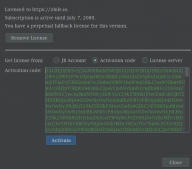本文介绍了python使用tensorflow深度学习识别验证码 ,分享给大家,具体如下:
除了传统的PIL包处理图片,然后用pytessert+OCR识别意外,还可以使用tessorflow训练来识别验证码。
此篇代码大部分是转载的,只改了很少地方。
代码是运行在linux环境,tessorflow没有支持windows的python 2.7。
gen_captcha.py代码。
|
1
2
3
4
5
6
7
8
9
10
11
12
13
14
15
16
17
18
19
20
21
22
23
24
25
26
27
28
29
30
31
32
33
34
35
36
37
38
39
40
41
42
43
44
45
46
47
48
49
50
51
52
53
54
55
56
57
58
59
60
61
62
63
64
65
66
67
68
69
|
#coding=utf-8from captcha.image import ImageCaptcha # pip install captchaimport numpy as npimport matplotlib.pyplot as pltfrom PIL import Imageimport random# 验证码中的字符, 就不用汉字了number = ['0', '1', '2', '3', '4', '5', '6', '7', '8', '9']alphabet = ['a', 'b', 'c', 'd', 'e', 'f', 'g', 'h', 'i', 'j', 'k', 'l', 'm', 'n', 'o', 'p', 'q', 'r', 's', 't', 'u', 'v', 'w', 'x', 'y', 'z']ALPHABET = ['A', 'B', 'C', 'D', 'E', 'F', 'G', 'H', 'I', 'J', 'K', 'L', 'M', 'N', 'O', 'P', 'Q', 'R', 'S', 'T', 'U', 'V', 'W', 'X', 'Y', 'Z']'''number=['0','1','2','3','4','5','6','7','8','9']alphabet =[]ALPHABET =[]'''# 验证码一般都无视大小写;验证码长度4个字符def random_captcha_text(char_set=number + alphabet + ALPHABET, captcha_size=4): captcha_text = [] for i in range(captcha_size): c = random.choice(char_set) captcha_text.append(c) return captcha_text# 生成字符对应的验证码def gen_captcha_text_and_image(): while(1): image = ImageCaptcha() captcha_text = random_captcha_text() captcha_text = ''.join(captcha_text) captcha = image.generate(captcha_text) #image.write(captcha_text, captcha_text + '.jpg') # 写到文件 captcha_image = Image.open(captcha) #captcha_image.show() captcha_image = np.array(captcha_image) if captcha_image.shape==(60,160,3): break return captcha_text, captcha_imageif __name__ == '__main__': # 测试 text, image = gen_captcha_text_and_image() print image gray = np.mean(image, -1) print gray print image.shape print gray.shape f = plt.figure() ax = f.add_subplot(111) ax.text(0.1, 0.9, text, ha='center', va='center', transform=ax.transAxes) plt.imshow(image) plt.show() |
train.py代码。
|
1
2
3
4
5
6
7
8
9
10
11
12
13
14
15
16
17
18
19
20
21
22
23
24
25
26
27
28
29
30
31
32
33
34
35
36
37
38
39
40
41
42
43
44
45
46
47
48
49
50
51
52
53
54
55
56
57
58
59
60
61
62
63
64
65
66
67
68
69
70
71
72
73
74
75
76
77
78
79
80
81
82
83
84
85
86
87
88
89
90
91
92
93
94
95
96
97
98
99
100
101
102
103
104
105
106
107
108
109
110
111
112
113
114
115
116
117
118
119
120
121
122
123
124
125
126
127
128
129
130
131
132
133
134
135
136
137
138
139
140
141
142
143
144
145
146
147
148
149
150
151
152
153
154
155
156
157
158
159
160
161
162
163
164
165
166
167
168
169
170
171
172
173
174
175
176
177
178
179
180
181
182
183
184
185
186
187
188
189
190
191
192
193
194
195
196
197
198
199
200
201
202
203
204
205
206
207
208
209
210
211
212
213
214
215
216
217
218
219
220
|
#coding=utf-8from gen_captcha import gen_captcha_text_and_imagefrom gen_captcha import numberfrom gen_captcha import alphabetfrom gen_captcha import ALPHABETimport numpy as npimport tensorflow as tf"""text, image = gen_captcha_text_and_image()print "验证码图像channel:", image.shape # (60, 160, 3)# 图像大小IMAGE_HEIGHT = 60IMAGE_WIDTH = 160MAX_CAPTCHA = len(text)print "验证码文本最长字符数", MAX_CAPTCHA # 验证码最长4字符; 我全部固定为4,可以不固定. 如果验证码长度小于4,用'_'补齐"""IMAGE_HEIGHT = 60IMAGE_WIDTH = 160MAX_CAPTCHA = 4# 把彩色图像转为灰度图像(色彩对识别验证码没有什么用)def convert2gray(img): if len(img.shape) > 2: gray = np.mean(img, -1) # 上面的转法较快,正规转法如下 # r, g, b = img[:,:,0], img[:,:,1], img[:,:,2] # gray = 0.2989 * r + 0.5870 * g + 0.1140 * b return gray else: return img"""cnn在图像大小是2的倍数时性能最高, 如果你用的图像大小不是2的倍数,可以在图像边缘补无用像素。np.pad(image,((2,3),(2,2)), 'constant', constant_values=(255,)) # 在图像上补2行,下补3行,左补2行,右补2行"""# 文本转向量char_set = number + alphabet + ALPHABET + ['_'] # 如果验证码长度小于4, '_'用来补齐CHAR_SET_LEN = len(char_set)def text2vec(text): text_len = len(text) if text_len > MAX_CAPTCHA: raise ValueError('验证码最长4个字符') vector = np.zeros(MAX_CAPTCHA * CHAR_SET_LEN) def char2pos(c): if c == '_': k = 62 return k k = ord(c) - 48 if k > 9: k = ord(c) - 55 if k > 35: k = ord(c) - 61 if k > 61: raise ValueError('No Map') return k for i, c in enumerate(text): #print text idx = i * CHAR_SET_LEN + char2pos(c) #print i,CHAR_SET_LEN,char2pos(c),idx vector[idx] = 1 return vector#print text2vec('1aZ_')# 向量转回文本def vec2text(vec): char_pos = vec.nonzero()[0] text = [] for i, c in enumerate(char_pos): char_at_pos = i # c/63 char_idx = c % CHAR_SET_LEN if char_idx < 10: char_code = char_idx + ord('0') elif char_idx < 36: char_code = char_idx - 10 + ord('A') elif char_idx < 62: char_code = char_idx - 36 + ord('a') elif char_idx == 62: char_code = ord('_') else: raise ValueError('error') text.append(chr(char_code)) return "".join(text)"""#向量(大小MAX_CAPTCHA*CHAR_SET_LEN)用0,1编码 每63个编码一个字符,这样顺利有,字符也有vec = text2vec("F5Sd")text = vec2text(vec)print(text) # F5Sdvec = text2vec("SFd5")text = vec2text(vec)print(text) # SFd5"""# 生成一个训练batchdef get_next_batch(batch_size=128): batch_x = np.zeros([batch_size, IMAGE_HEIGHT * IMAGE_WIDTH]) batch_y = np.zeros([batch_size, MAX_CAPTCHA * CHAR_SET_LEN]) # 有时生成图像大小不是(60, 160, 3) def wrap_gen_captcha_text_and_image(): while True: text, image = gen_captcha_text_and_image() if image.shape == (60, 160, 3): return text, image for i in range(batch_size): text, image = wrap_gen_captcha_text_and_image() image = convert2gray(image) batch_x[i, :] = image.flatten() / 255 # (image.flatten()-128)/128 mean为0 batch_y[i, :] = text2vec(text) return batch_x, batch_y####################################################################X = tf.placeholder(tf.float32, [None, IMAGE_HEIGHT * IMAGE_WIDTH])Y = tf.placeholder(tf.float32, [None, MAX_CAPTCHA * CHAR_SET_LEN])keep_prob = tf.placeholder(tf.float32) # dropout# 定义CNNdef crack_captcha_cnn(w_alpha=0.01, b_alpha=0.1): x = tf.reshape(X, shape=[-1, IMAGE_HEIGHT, IMAGE_WIDTH, 1]) # w_c1_alpha = np.sqrt(2.0/(IMAGE_HEIGHT*IMAGE_WIDTH)) # # w_c2_alpha = np.sqrt(2.0/(3*3*32)) # w_c3_alpha = np.sqrt(2.0/(3*3*64)) # w_d1_alpha = np.sqrt(2.0/(8*32*64)) # out_alpha = np.sqrt(2.0/1024) # 3 conv layer w_c1 = tf.Variable(w_alpha * tf.random_normal([3, 3, 1, 32])) b_c1 = tf.Variable(b_alpha * tf.random_normal([32])) conv1 = tf.nn.relu(tf.nn.bias_add(tf.nn.conv2d(x, w_c1, strides=[1, 1, 1, 1], padding='SAME'), b_c1)) conv1 = tf.nn.max_pool(conv1, ksize=[1, 2, 2, 1], strides=[1, 2, 2, 1], padding='SAME') conv1 = tf.nn.dropout(conv1, keep_prob) w_c2 = tf.Variable(w_alpha * tf.random_normal([3, 3, 32, 64])) b_c2 = tf.Variable(b_alpha * tf.random_normal([64])) conv2 = tf.nn.relu(tf.nn.bias_add(tf.nn.conv2d(conv1, w_c2, strides=[1, 1, 1, 1], padding='SAME'), b_c2)) conv2 = tf.nn.max_pool(conv2, ksize=[1, 2, 2, 1], strides=[1, 2, 2, 1], padding='SAME') conv2 = tf.nn.dropout(conv2, keep_prob) w_c3 = tf.Variable(w_alpha * tf.random_normal([3, 3, 64, 64])) b_c3 = tf.Variable(b_alpha * tf.random_normal([64])) conv3 = tf.nn.relu(tf.nn.bias_add(tf.nn.conv2d(conv2, w_c3, strides=[1, 1, 1, 1], padding='SAME'), b_c3)) conv3 = tf.nn.max_pool(conv3, ksize=[1, 2, 2, 1], strides=[1, 2, 2, 1], padding='SAME') conv3 = tf.nn.dropout(conv3, keep_prob) # Fully connected layer w_d = tf.Variable(w_alpha * tf.random_normal([8 * 32 * 40, 1024])) b_d = tf.Variable(b_alpha * tf.random_normal([1024])) dense = tf.reshape(conv3, [-1, w_d.get_shape().as_list()[0]]) dense = tf.nn.relu(tf.add(tf.matmul(dense, w_d), b_d)) dense = tf.nn.dropout(dense, keep_prob) w_out = tf.Variable(w_alpha * tf.random_normal([1024, MAX_CAPTCHA * CHAR_SET_LEN])) b_out = tf.Variable(b_alpha * tf.random_normal([MAX_CAPTCHA * CHAR_SET_LEN])) out = tf.add(tf.matmul(dense, w_out), b_out) # out = tf.nn.softmax(out) return out# 训练def train_crack_captcha_cnn(): import time start_time=time.time() output = crack_captcha_cnn() # loss #loss = tf.reduce_mean(tf.nn.softmax_cross_entropy_with_logits(output, Y)) loss = tf.reduce_mean(tf.nn.sigmoid_cross_entropy_with_logits(logits=output, labels=Y)) # 最后一层用来分类的softmax和sigmoid有什么不同? # optimizer 为了加快训练 learning_rate应该开始大,然后慢慢衰 optimizer = tf.train.AdamOptimizer(learning_rate=0.001).minimize(loss) predict = tf.reshape(output, [-1, MAX_CAPTCHA, CHAR_SET_LEN]) max_idx_p = tf.argmax(predict, 2) max_idx_l = tf.argmax(tf.reshape(Y, [-1, MAX_CAPTCHA, CHAR_SET_LEN]), 2) correct_pred = tf.equal(max_idx_p, max_idx_l) accuracy = tf.reduce_mean(tf.cast(correct_pred, tf.float32)) saver = tf.train.Saver() with tf.Session() as sess: sess.run(tf.global_variables_initializer()) step = 0 while True: batch_x, batch_y = get_next_batch(64) _, loss_ = sess.run([optimizer, loss], feed_dict={X: batch_x, Y: batch_y, keep_prob: 0.75}) print time.strftime('%Y-%m-%d %H:%M:%S',time.localtime(time.time())),step, loss_ # 每100 step计算一次准确率 if step % 100 == 0: batch_x_test, batch_y_test = get_next_batch(100) acc = sess.run(accuracy, feed_dict={X: batch_x_test, Y: batch_y_test, keep_prob: 1.}) print u'***************************************************************第%s次的准确率为%s'%(step, acc) # 如果准确率大于50%,保存模型,完成训练 if acc > 0.9: ##我这里设了0.9,设得越大训练要花的时间越长,如果设得过于接近1,很难达到。如果使用cpu,花的时间很长,cpu占用很高电脑发烫。 saver.save(sess, "crack_capcha.model", global_step=step) print time.time()-start_time break step += 1train_crack_captcha_cnn() |
测试代码:
|
1
2
3
4
5
6
7
8
9
10
11
12
13
14
15
16
17
18
19
20
21
22
23
24
25
26
|
output = crack_captcha_cnn()saver = tf.train.Saver()sess = tf.Session()saver.restore(sess, tf.train.latest_checkpoint('.'))while(1): text, image = gen_captcha_text_and_image() image = convert2gray(image) image = image.flatten() / 255 predict = tf.argmax(tf.reshape(output, [-1, MAX_CAPTCHA, CHAR_SET_LEN]), 2) text_list = sess.run(predict, feed_dict={X: [image], keep_prob: 1}) predict_text = text_list[0].tolist() vector = np.zeros(MAX_CAPTCHA * CHAR_SET_LEN) i = 0 for t in predict_text: vector[i * 63 + t] = 1 i += 1 # break print("正确: {} 预测: {}".format(text, vec2text(vector))) |
如果想要快点测试代码效果,验证码的字符不要设置太多,例如0123这几个数字就可以了。
以上就是本文的全部内容,希望对大家的学习有所帮助,也希望大家多多支持服务器之家。
原文链接:https://www.cnblogs.com/ydf0509/p/6916435.html





